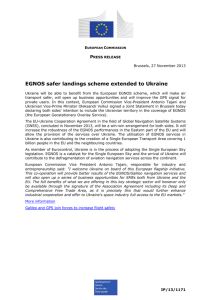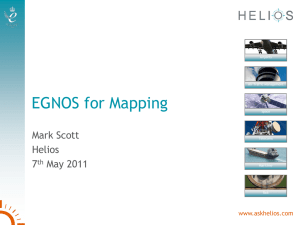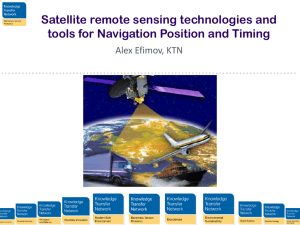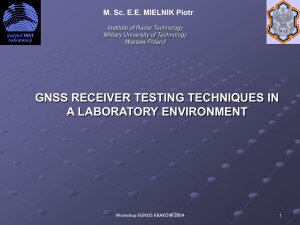SBAS
advertisement
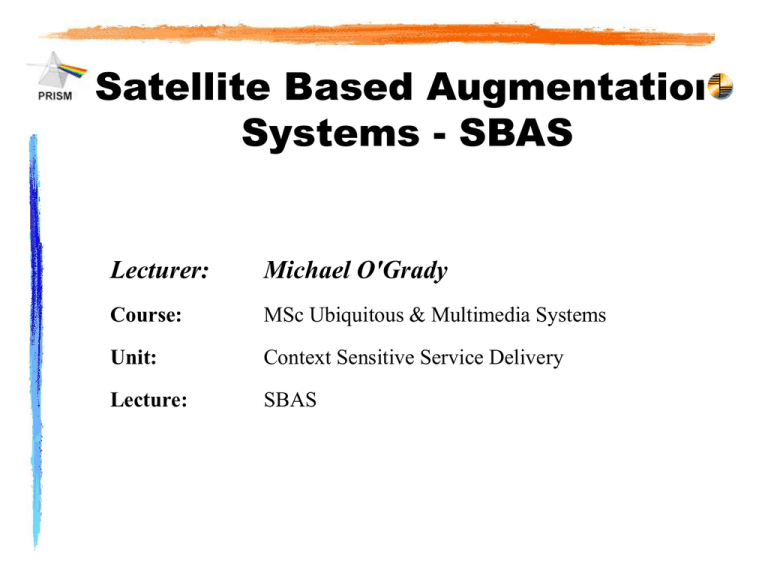
Satellite Based Augmentation Systems - SBAS Lecturer: Michael O'Grady Course: MSc Ubiquitous & Multimedia Systems Unit: Context Sensitive Service Delivery Lecture: SBAS Objectives Outline current developments in Satellite Based Augmentation Systems (SBASs) Satellite - Current Developments Global Navigation Satellite System (GNSS) • Aims to resolve the conflict between civilian and military demands • seeks to provide position readings to within 3 metres Two phases GNSS-1 • Resolves most technical issues • Political issues still remains • Introduces Satellite Based Augmentation Systems (SBASs) GNSS-2 • Seeks to provide a global infrastructure for positioning and timing GNSS-1 - EGNOS European Geostationary Navigation Overlay System (EGNOS) Developed by • European Commission • Eurocontrol • European Space Agency Coverage area includes • all Europe, Africa and the Middle East • parts of Asia and South America Uses INMARSAT-3 satellites for broadcasting correctional and integrity data Scheduled for launch in 2006 GNSS-1 - WAAS Wide Area Augmentation System (WAAS) Designed by the Federal Aviation Authority (FAA) Designed to provide precise navigational services to aircraft for the duration of flight Network of 25 ground stations spread across the USA INMARSAT-3 used to broadcast connections • same frequency as GPS signal • Receiver must be WAAS enabled • Currently being deployed GNSS-1 - LAAS Local Area Augmentation System (LAAS) intended to operate when WAAS cannot •I.e when visibility is less than 1 km Deployed in the immediate vicinity of airports Will only broadcast data to aircraft in sight of the corresponding ground reference station GNSS-1 - MSAS Multifunctional Transport Satellite Augmentation System (MSAS) Services include Navigation Meteorology Architecture • 24 ground stations • 2 satellites Features • Area covered include most Asia/Pacific air space • Compatible with EGNOS and WAAS • Developed solely by Japan GNSS – Developments India GAGAN China SNAS Canada CWAAS EGNOS - Services GEO Ranging GPS-like signals GMSS Integrity Channel Signal integrity information Wide Area Differential (WAD) Differential corrections EGNOS - ARCHITECTURE Four Segments Space Ground User Support Facilities EGNOS Diagram EGNOS – Space Segment Three Geostationary transponders INMARSAT-3 AOR-E INMARSAT-3 AOR-W ESA ARTEMIS EGNOS Ground Segment - RIMS Ranging and Integrity Monitoring Stations (RIMS) GPS, GLONASS, EGNOS(!) 34 stations (mainly in Europe) • GPS/GLONASS/EGNOS receiver • Atomic clock • Network access RIMS tasks Pseudorange measurements Demodulate SIS messages Mitigate multipath & interference Verify signal integrity Packet & transmit data to MCC EGNOS Ground Segment - MCC Mission/Master Control Centre (MCC) • 4 stations in Europe • Monitoring & control of EGNOS • Real-time software processing MCC tasks • • • • Integrity determination Pseudo-range corrections for each satellite Ionospheric delay Generate Satellite (EGNOS) ephemeris EGNOS Ground Segment - NLES Navigation Land Earth Station (NLES) Two for each satellite (EGNOS) • 1 primary • 1 backup One for Test & Validation NLES Tasks • • • • Generate GPS-like signal Generate GIC signal (GNSS Integrity Channel) Generate Wide Area Differential (WAD) signal Transmit signals to GEO (EGNOS) EGNOS Ground Segment - EWAN EGNOS Wide Area Network Links all EGNOS ground-based components EGNOS – User Segment EGNOS Receiver Uses Civil Aviation Land Marine EGNOS – Support Facilities Support for Development Operations Verifications SISNet Signal In Space over the Internet (SISNet) Provides EGNOS signal over standard TCP/IP connection User Requirements PDA/mobile phone Wireless data connection e.g. GPRS GPS card/receiver Why SISNet? Recall … Geostationary orbits Low elevation angles So………… Consider In urban canyon? At high latitudes? References ESA WWW site EGNOS SISNet SpringerLink GPS Solutions
